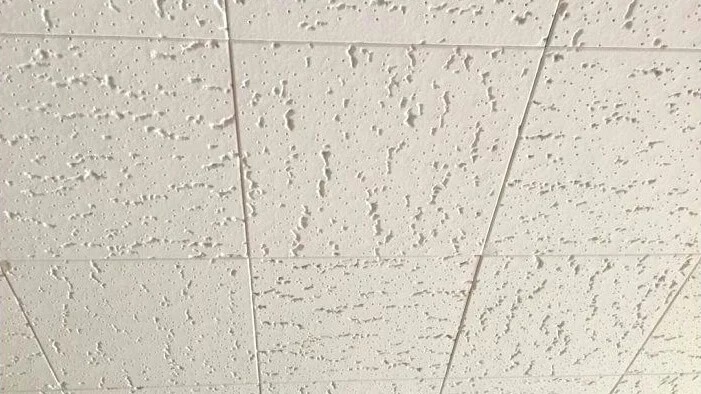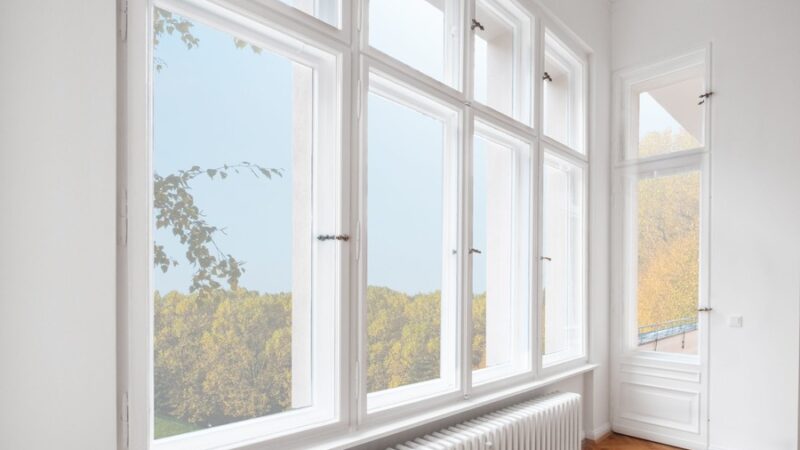Historical Use of Asbestos in Ceiling Tiles
Asbestos, a once-popular building material, was widely used in ceiling tiles from the 1920s until the mid-1980s. Its popularity stemmed from its durability and resistance to heat and fire, making it a cost-effective option for many builders. These tiles were commonly installed in basements and kitchens, primarily to cover ductwork. The tiles, often referred to as suspended or drop ceilings, came in standard sizes like 2×2 or 2×4 feet, and featured a square or rectangular shape. They were typically light in color, with a mild texture and pinhole markings. However, identifying asbestos just by appearance is tricky since the fibers are not visible to the naked eye. Sampling and testing remain the most reliable methods for confirmation.
Common Types of Asbestos Found in Ceiling Tiles
Different types of asbestos were used in ceiling tiles, each with distinct properties. The most common types included:
- Crocidolite Asbestos: Known for its blue color, it was used for its strength and resistance.
- Chrysotile Asbestos: Often called white asbestos, it was the most widely used form and found in various ceiling materials.
- Amosite Asbestos: Also known as brown asbestos, it was prevalent in ceiling, floor, and roofing tiles.
These varieties contributed to the tiles’ effectiveness but also increased health risks when disturbed.
Health Risks Associated with Asbestos Exposure
Exposure to asbestos fibers poses significant health risks. When these tiles are damaged or disturbed, they can release fibers into the air, which, when inhaled, can lead to serious health issues. Asbestos exposure is linked to diseases such as lung cancer, asbestosis, and mesothelioma, a rare cancer affecting the lining of the lungs or abdomen. The risk increases with prolonged exposure, making it crucial to handle asbestos-containing materials with care. For those living in homes with suspected asbestos tiles, it is advisable to seek professional assessment and avoid any DIY removal or renovation attempts. For more details on the appearance of asbestos, understanding the visual cues can be helpful, but professional testing is recommended for accuracy.
Identifying Asbestos in Basement Ceiling Tiles
Visual Indicators of Asbestos Ceiling Tiles
Identifying asbestos in ceiling tiles isn’t always straightforward, but there are some visual cues that can help. Tiles from homes built between the 1920s and mid-1980s are often suspect. These tiles typically have a square or rectangular shape, measuring about 2×2 or 2×4 feet. They might appear light in color with a mild texture, and sometimes you’ll notice pinhole markings or a powdery look. However, these features alone aren’t enough to confirm the presence of asbestos, as many tiles look similar.
Professional Testing for Asbestos
To definitively determine if your ceiling tiles contain asbestos, professional testing is essential. Disturbing the tiles can release fibers into the air, so it’s crucial to handle them correctly. A trained professional will take a sample of the material and analyze it in a lab. This process ensures that the material is handled safely and accurately assessed for asbestos content. Hiring a professional is the best way to avoid health risks associated with asbestos exposure.
Common Misconceptions About Asbestos Identification
There are several misconceptions about identifying asbestos in ceiling tiles. Some believe that only older homes contain asbestos, but renovations can introduce it too. Another common myth is that asbestos can be identified by appearance alone, which isn’t true. Even tiles that look harmless might contain asbestos. It’s also a mistake to assume that all ceiling tiles from a certain era contain asbestos; not all do. The most reliable way to identify asbestos is through professional testing, not guesswork.
How to Check for Asbestos in Basement Ceiling Tiles
Steps for Safe Asbestos Inspection
Checking for asbestos in basement ceiling tiles is a task that requires utmost caution. Safety should be your top priority to avoid any health risks associated with asbestos exposure. Here’s a simple guide to help you through the process:
- Visual Inspection: Start by examining the tiles closely. Look for any signs that might indicate asbestos, such as a powdery appearance or pinhole markings.
- Check for Labels: Look for any manufacturer stamps or labels on the tiles. These can sometimes provide information on whether asbestos is present.
- Home’s Construction Date: Consider the age of your home. If it was built before the mid-1980s, there’s a higher chance that asbestos might be present.
- Professional Testing: When in doubt, it’s best to hire a professional to conduct a thorough asbestos test. Disturbing the tiles yourself could release harmful fibers into the air.
Tools and Equipment Needed for Asbestos Testing
Conducting an asbestos inspection requires certain tools and equipment to ensure safety and accuracy:
- Protective Gear: Always wear a mask and gloves to protect yourself from potential exposure.
- Flashlight: A good flashlight can help you see markings or textures on the tiles more clearly.
- Testing Kit: Consider using a PRO-LAB Asbestos Test Kit to safely collect samples for laboratory analysis.
When to Call a Professional
Identifying asbestos can be tricky, and sometimes it’s best left to the experts. Here are situations where you should definitely call in a professional:
- Uncertain Results: If your inspection is inconclusive, a professional can provide a definitive answer.
- Pre-Renovation Checks: Before starting any renovation work, ensure that your ceiling tiles are asbestos-free.
- Health Concerns: If anyone in your household has respiratory issues, it’s safer to have a professional handle the inspection.
The Dangers of Asbestos in Basement Ceiling Tiles
Asbestos exposure is a serious concern, especially when it comes to old ceiling tiles in basements. These tiny fibers, when inhaled, can lead to severe health issues, including lung cancer and mesothelioma. Asbestos fibers are notorious for lodging themselves in the lining of the lungs or abdomen, causing irritation and eventually leading to cancer. The latency period for these diseases can be decades, meaning symptoms might not appear until many years after exposure.
- Mesothelioma: A rare cancer that affects the lining of the lungs, heart, or abdomen.
- Lung Cancer: Often linked to smoking, but asbestos exposure significantly increases the risk.
- Asbestosis: A chronic lung disease causing scarring of lung tissue.
For those living in older homes, the risk of asbestos exposure is particularly high, especially if the tiles are damaged or disturbed.
Legal Consequences of Asbestos Negligence
Homeowners and landlords have a legal responsibility to ensure their properties are safe. If asbestos is present and not properly managed or disclosed, they could face hefty fines and lawsuits. Many countries have strict regulations regarding asbestos management, and failing to comply can lead to significant legal repercussions.
- Disclosure Requirements: Property sellers must inform buyers of any known asbestos.
- Regulatory Compliance: Ensuring all renovations comply with asbestos safety laws.
- Potential Lawsuits: Legal action from tenants or buyers if asbestos-related health issues arise.
Long-term Effects of Asbestos in Homes
The presence of asbestos in homes not only poses immediate health risks but can also have long-lasting effects on property value and safety. Asbestos materials degrade over time, increasing the likelihood of fiber release into the air.
- Devaluation of Property: Homes with asbestos may be harder to sell and often at a lower price.
- Ongoing Maintenance: Regular inspections and potential encapsulation or removal.
- Health Monitoring: Residents may need regular health check-ups to monitor for asbestos-related diseases.
In conclusion, the dangers of asbestos in basement ceiling tiles are not to be underestimated. Damaged or disturbed tiles can release harmful fibers into the air, posing serious health risks. It’s crucial for homeowners to address these issues promptly and responsibly.
Safe Removal of Asbestos Ceiling Tiles
Hiring a Certified Asbestos Removal Professional
When it comes to dealing with asbestos ceiling tiles, the safest route is to hire licensed professionals. These experts are trained to handle asbestos with care, ensuring that all safety regulations are met. Hiring licensed asbestos abatement professionals not only guarantees proper removal but also helps in avoiding potential health risks associated with improper handling. Professionals use specialized equipment and follow strict procedures to prevent asbestos fibers from becoming airborne during removal. This is crucial because, once disturbed, asbestos fibers can pose significant health risks.
DIY Asbestos Removal: Risks and Precautions
While some might consider removing asbestos ceiling tiles themselves to save on costs, this approach is fraught with dangers. Asbestos is a hazardous material, and without the right equipment and knowledge, attempting a DIY removal can lead to serious health issues. If you choose to go this route, it’s essential to take extreme precautions:
- Wear protective clothing, including masks and gloves.
- Seal off the area to prevent contamination of other parts of the house.
- Wet the tiles before removal to minimize dust.
However, even with these precautions, the risk remains high, and it’s generally advised to leave this task to professionals.
Cost Considerations for Asbestos Removal
The cost of removing asbestos ceiling tiles can vary, typically ranging from $5 to $15 per square foot. This price includes the labor, disposal, and safety measures required for safe removal. It’s important to factor in not just the removal costs but also the expense of replacing the ceiling tiles once the asbestos has been dealt with. While professional removal might seem costly upfront, it is a worthwhile investment for the safety and peace of mind it provides.
Alternatives to Asbestos Ceiling Tiles
Modern Materials for Ceiling Tiles
In the quest for safer homes, modern materials have become the go-to choice for ceiling tiles. These materials not only eliminate the health risks associated with asbestos but also offer enhanced aesthetic appeal and durability. One popular option is mineral fiber tiles, which are made from recycled materials and provide excellent sound absorption. PVC tiles are another alternative; they are lightweight, easy to install, and resistant to moisture and mold. For those seeking a more natural look, wood fiber tiles offer a warm, organic appearance while still maintaining fire resistance. Choosing the right material can transform a space while ensuring safety and compliance with modern building standards.
Benefits of Asbestos-Free Ceiling Options
Switching to asbestos-free ceiling tiles comes with a host of benefits. First and foremost, it significantly reduces health risks, safeguarding occupants from asbestos-related diseases. These modern tiles are also environmentally friendly, often made from recycled or sustainable materials. They tend to be more durable, resisting wear and tear better than their asbestos counterparts. Moreover, many of these tiles are designed for easy installation and maintenance, making them a cost-effective choice in the long run. Homeowners can enjoy peace of mind knowing that their ceiling tiles are safe and sustainable.
Environmental Impact of Asbestos Alternatives
The shift from asbestos to modern ceiling materials not only benefits personal health but also the environment. Asbestos mining and processing have long been associated with environmental degradation. In contrast, many asbestos alternatives are produced with sustainability in mind. For instance, mineral fiber tiles often incorporate recycled materials, reducing waste and conserving natural resources. By choosing eco-friendly ceiling tiles, homeowners contribute to a healthier planet while enhancing their living spaces. This choice supports the growing demand for green building materials and helps reduce the carbon footprint associated with traditional construction practices. In conclusion, opting for asbestos-free ceiling tiles is a step towards a more sustainable future.
Legal Regulations on Asbestos Use
Historical Legislation on Asbestos
In the early days, asbestos was hailed as a “miracle mineral,” leading to its widespread use in construction and manufacturing. However, its health risks soon became apparent, prompting legal action. In the 1970s, the Environmental Protection Agency (EPA) began efforts to curb asbestos use. The Clean Air Act of 1978 was a pivotal regulation, allowing the EPA to set air quality standards and ban asbestos in certain products, such as ceiling tiles. The Toxic Substances Control Act (TSCA) further empowered the EPA to oversee how asbestos products were labeled and managed.
Current Laws Governing Asbestos in Construction
Today, asbestos regulations are more stringent, reflecting a deeper understanding of its hazards. The Asbestos Hazard Emergency Response Act (AHERA) mandates that schools inspect for asbestos and prepare management plans. Additionally, the Asbestos National Emission Standards for Hazardous Air Pollutants (NESHAP) outlines requirements for demolishing or renovating buildings containing asbestos. These regulations aim to minimize asbestos exposure and protect public health.
Future Trends in Asbestos Regulation
Looking ahead, the focus will likely shift towards stricter enforcement and possibly outright bans on remaining asbestos uses. Increased public awareness and advocacy are driving forces behind potential legislative changes. As science advances, there may be new methods to safely remove or neutralize asbestos, reducing its presence in homes and workplaces. The ongoing dialogue between policymakers, scientists, and the public will shape the future of asbestos regulation.
Companies Involved in Asbestos Ceiling Tile Production
Major Manufacturers of Asbestos Ceiling Tiles
During the 20th century, several companies were heavily involved in the production of asbestos ceiling tiles. These manufacturers played a significant role in the widespread use of asbestos in building materials. Among the most notable were Johns Manville, National Gypsum Company, and Armstrong World Industries. These companies, among others, were pivotal in integrating asbestos into their ceiling tile products due to its heat resistance and durability.
- Johns Manville: Known for producing a variety of asbestos-containing products, this company was a leader in the industry.
- National Gypsum Company: Another major player, they manufactured a wide range of building materials incorporating asbestos.
- Armstrong World Industries: Famous for their ceiling tiles, they also used asbestos in various products.
Corporate Responsibility and Asbestos
The use of asbestos by these companies raises significant questions about corporate responsibility. Many of these manufacturers were aware of the health risks associated with asbestos exposure but continued production regardless. This decision has led to numerous lawsuits and financial liabilities, with companies establishing trust funds to compensate affected individuals. The ethical implications of their actions continue to be a topic of debate.
Bankruptcy and Compensation for Asbestos Victims
As the health risks of asbestos became undeniable, several of these companies faced overwhelming legal challenges. Many, such as Owens-Corning and Flintkote Company, filed for bankruptcy as a result of the financial burden from lawsuits. In response, they set up compensation trusts to provide financial restitution to victims of asbestos-related illnesses. These trust funds remain a critical resource for those seeking compensation for the harm caused by asbestos exposure.
Preventive Measures for Asbestos Exposure
Regular Inspection and Maintenance
Keeping an eye on potential asbestos-containing materials in your home is key. Regular inspections help you catch any issues early. If your house was built before the 1980s, there’s a chance asbestos might be lurking in the ceiling tiles, insulation, or even the floor tiles. Routine checks can prevent accidental exposure. Make sure to look for signs of wear and tear, like cracks or crumbling materials. If you spot anything suspicious, it’s wise to consult with a professional for further evaluation.
Encapsulation as a Temporary Solution
Sometimes, removing asbestos isn’t immediately feasible. In such cases, encapsulation can serve as a temporary fix. This process involves applying a sealant that binds the asbestos fibers together, reducing the risk of them becoming airborne. While this doesn’t remove the asbestos, it does minimize the danger until a more permanent solution can be arranged. It’s important to note that encapsulation should be performed by a professional to ensure safety.
Educating Homeowners on Asbestos Risks
Knowledge is power when it comes to asbestos. Homeowners should be informed about the potential risks and safety measures related to asbestos exposure. This includes understanding the importance of not disturbing materials that might contain asbestos and knowing when to call in the experts. Workshops, brochures, and community talks can be effective ways to spread awareness. By staying informed, homeowners can make better decisions to protect their families from asbestos-related health issues.
For more information on asbestos regulations, you might want to explore the EPA’s rule on asbestos use, which outlines measures to protect the public from exposure.
The Role of Asbestos in Acoustic Ceiling Tiles
Acoustic Benefits of Asbestos Ceiling Tiles
Back in the day, asbestos was a popular choice for acoustic ceiling tiles, mainly because it was cheap and had great soundproofing abilities. These tiles were fantastic at cutting down noise, making them a go-to option for places like churches, lecture halls, and recording studios. They helped to manage sound and keep large spaces quieter. People loved how they could keep the noise down while also brightening up a room.
Risks of Acoustic Asbestos Tiles
While asbestos ceiling tiles were great for sound, they came with some serious health risks. If the tiles are disturbed, they can release asbestos fibers into the air. Breathing in these fibers can lead to severe health problems, including lung cancer and mesothelioma. It’s especially risky when the tiles are broken or damaged, as the fibers become airborne. The danger is real, and that’s why it’s important to handle these tiles with care.
Alternatives to Acoustic Asbestos Tiles
Today, there are many safer alternatives to asbestos for acoustic tiles. Modern materials like fiberglass and mineral wool offer similar soundproofing benefits without the health risks. These new options are not only safer but also environmentally friendly. They help keep the sound down just like the old asbestos tiles, but without the worry of releasing harmful fibers into the air. Switching to these materials can make spaces safer and healthier for everyone.
Expert Insights







